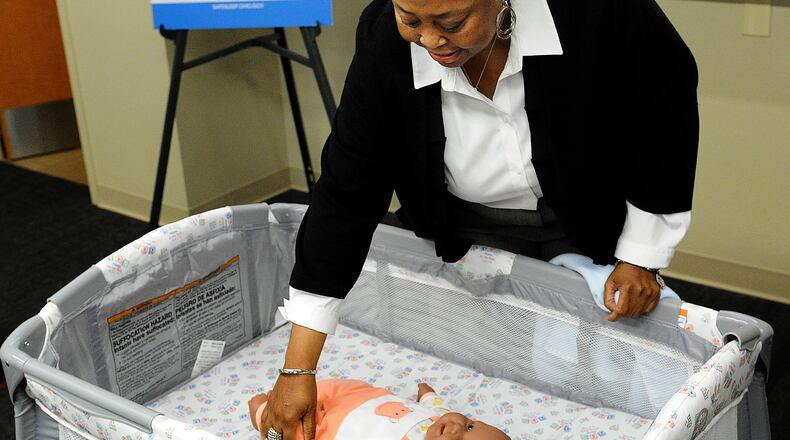Montgomery County’s infant mortality rate was approximately 9.8 infant deaths per 1,000 live births in 2023, according to Public Health - Dayton & Montgomery County’s Community Health Assessment.
When taking race into account, the infant mortality rate for Black infants, 16.3 deaths per 1,000 live births, was more than twice as high as white infants, 6.5 deaths per 1,000 live births.
Groundwork Ohio, in conjunction with CareSource, interviewed more than 3,000 women across Ohio, including more than 100 women and community members in Montgomery County.
“Reducing infant mortality requires more than data—it demands that we listen to the voices of pregnant women, understand their challenges, and act with urgency to remove barriers to care,” said Deirdra Yocum, interim president of the Ohio Market for CareSource, a Dayton-based health insurer.
Experiences in Dayton region less positive
While the majority of women’s birthing experiences in Montgomery County have been positive, according to Groundwork Ohio’s survey of local women, they weren’t as positive as the average experience across Ohio.
Statewide, more than 80% of the participants felt involved in their birth experience, specifically:
- 85.4% of women across Ohio reported that they either agree or strongly agree that their health care provider included them in the decision-making process during their pregnancy
- 84.1% said they received explanations for tests and procedures during their pregnancy.
- 84.9% said the hospital care team listened to them and explained care options during the birth of their child.
A smaller percentage of Montgomery County residents felt included in their health care during their pregnancy, specifically:
- 79% of the women interviewed in Montgomery County agreed or strongly agreed that their health care provider included them in the decision-making process during their pregnancy.
- 81% said they received explanations for tests and procedures during their pregnancy.
- 79.2% said the hospital care team listened to them and explained care options during the birth of their child.
“Their lived experiences must shape the policies and solutions that drive real change and together we will create healthier communities,” Yocum said.
Among the many factors assumed to have had a negative influence on the quality of care from physicians, nurses and the hospital staff, the top three for all respondents statewide were:
- Income at 43.9% when it came to women’s interactions with physicians, 40% with women’s experiences with nurses and 40% with their experiences with hospital staff
- Health insurance coverage at 41.1% with physicians, 38.4% with nurses and 35.2% with hospital staff
- Respondent’s own health at 28.9% with physicians, 26.1% with nurses and 27.6% with hospital staff
- Race/ethnicity at 21.6% with physicians, 22.8% with nurses and 23% hospital staff
Black respondents reported race/ethnicity as the top factor negatively impacting their care from physicians (41%), nurses (41%) and hospital staff (39%), according to Groundwork Ohio’s report.
Anonymous quotes within the report describe women who felt pressured to give birth through a Cesarean section, or C-section, which is a surgical procedure used to deliver a baby through an incision in the mother’s abdomen and uterus.
One woman who was about to go through a C-section said she could still feel the left side of her body when they went in to do the procedure. When she told the doctor, he said that pressure was just in her head and ignored her concerns, but the woman went into shock due to being able to feel the surgical procedure.
“I remember after the surgery, everyone had met my baby in this hospital but me,” the anonymous woman said.
Commitments to improve care
From here, Groundwork Ohio and CareSource hope the information in the report will help inform policy makers, from lawmakers to within health care companies themselves.
“It will change the way you think when you’re forced to hear them if you’re not regularly living these experiences on your own,” Gutierrez said.
The Greater Dayton Area Hospital Association (GDAHA) is making moves to improve people’s birthing experiences and address birthing needs. In partnership with Montgomery County, GDAHA relaunched the county’s Maternal and Infant Health Task Force in fall 2024.
“We acknowledge that economically disadvantaged women and women of color often feel unheard during their pregnancy and birthing experiences,” Sarah Hackenbracht, president and CEO of GDAHA.
In response, hospitals are collaborating with CareSource, Groundwork Ohio and other local partners to improve care and support for birthing moms in Montgomery County and the Dayton region, she said.
“We are committed to transforming these experiences by engaging clinical and executive leaders at every level—ensuring that all moms, regardless of background, feel heard, supported and empowered during their care," Hackenbracht said.
To read the full Threads of Hope report, visit https://www.groundworkohio.org/threads-of-hope.
By the numbers
Infant mortality by county according to 2022 data from the Ohio Department of Health:
- Butler County: 7.3 infant deaths per 100,000 live births
- Clark County: 7.1 infant deaths per 100,000 live births
- Greene County: 5.8 infant deaths per 100,000 live births
- Miami County: 6.5 infant deaths per 100,000 live births.
- Montgomery County: 8 infant deaths per 100,000 live births. More recent data for Montgomery County from Public Health - Dayton & Montgomery County showed that rate increased to 9.8 deaths per 100,000 live births in 2023.
- Champaign County: 4.8 infant deaths per 100,000 live births.
- Darke County: 4.7 infant deaths per 100,000 live births.
- Preble County: 4.8 infant deaths per 100,000 live births.
About the Author


